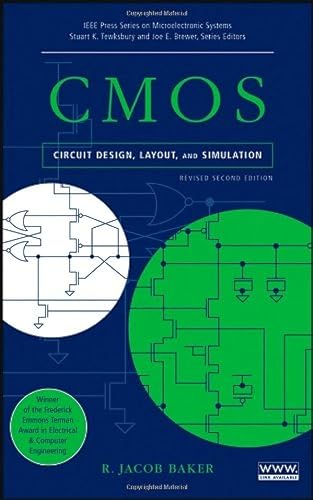
Synopsis
Winner of the Frederick Emmons Terman Award
CMOS: Circuit Design, Layout, and Simulation, Revised Second Edition covers the practical design of both analog and digital integrated circuits, offering a vital, contemporary view of a wide range of analog/digital circuit blocks, the BSIM model, data converter architectures, and much more. This edition takes a two-path approach to the topics: design techniques are developed for both long- and short-channel CMOS technologies and then compared. The results are multidimensional explanations that allow readers to gain deep insight into the design process. Features include:
- Updated materials to reflect CMOS technology's movement into nanometer sizes
- Discussions on phase- and delay-locked loops, mixed-signal circuits, data converters, and circuit noise
- More than 1,000 figures, 200 examples, and over 500 end-of-chapter problems
- In-depth coverage of both analog and digital circuit-level design techniques
- Real-world process parameters and design rules
The book's Web site, CMOSedu.com, provides: solutions to the book's problems; additional homework problems without solutions; SPICE simulation examples using HSPICE, LTspice, and WinSpice; layout tools and examples for actually fabricating a chip; and videos to aid learning
"synopsis" may belong to another edition of this title.
About the Author
R. Jacob (Jake) Baker is an engineer, educator, and inventor. He has more than twenty years of engineering experience and holds over 200 granted or pending patents in integrated circuit design.Jake is the author of several circuit design books for Wiley-IEEE Press. A more detailed biography is provided at the book's Web site.
From the Back Cover
Praise for
CMOS: Circuit Design, Layout, and SimulationRevised Second Edition
from the Technical Reviewers
"A refreshing industrial flavor. Design concepts are presented as they are needed for 'just-in-time' learning. Simulating and designing circuits using SPICE is emphasized with literally hundreds of examples. Very few textbooks contain as much detail as this one. Highly recommended!"
?Paul M. Furth, New Mexico State University
"This book builds a solid knowledge of CMOS circuit design from the ground up. With coverage of process integration, layout, analog and digital models, noise mechanisms, memory circuits, references, amplifiers, PLLs/DLLs, dynamic circuits, and data converters, the text is an excellent reference for both experienced and novice designers alike."
?Tyler J. Gomm, Design Engineer, Micron Technology, Inc.
"The Second Edition builds upon the success of the first with new chapters that cover additional material such as oversampled converters and non-volatile memories. This is becoming the de facto standard textbook to have on every analog and mixed-signal designer's bookshelf."
?Joe Walsh, Design Engineer, AMI Semiconductor
CMOS circuits from design to implementation
CMOS: Circuit Design, Layout, and Simulation, Revised Second Edition covers the practical design of both analog and digital integrated circuits, offering a vital, contemporary view of a wide range of analog/digital circuit blocks, the BSIM model, data converter architectures, and much more. This edition takes a two-path approach to the topics: design techniques are developed for both long- and short-channel CMOS technologies and then compared. The results are multidimensional explanations that allow readers to gain deep insight into the design process. Features include:
Updated materials to reflect CMOS technology's movement into nanometer sizes
Discussions on phase- and delay-locked loops, mixed-signal circuits, data converters, and circuit noise
More than 1,000 figures, 200 examples, and over 500 end-of-chapter problems
In-depth coverage of both analog and digital circuit-level design techniques
Real-world process parameters and design rules
The book's Web site, CMOSedu.com, provides: solutions to the book's problems; additional homework problems without solutions; SPICE simulation examples using HSPICE, LTspice, and WinSpice; layout tools and examples for actually fabricating a chip; and videos to aid learning
"About this title" may belong to another edition of this title.
Search results for CMOS Circuit Design, Layout, and Simulation, Revised...
CMOS Circuit Design, Layout, and Simulation, Revised Second Edition
Seller: Zoom Books Company, Lynden, WA, U.S.A.
Condition: very_good. Book is in very good condition and may include minimal underlining highlighting. The book can also include "From the library of" labels. May not contain miscellaneous items toys, dvds, etc. . We offer 100% money back guarantee and 24 7 customer service. Seller Inventory # ZBV.0470229411.VG
CMOS Circuit Design, Layout, and Simulation, Revised Second Edition
Seller: World of Books (was SecondSale), Montgomery, IL, U.S.A.
Condition: Good. Item in good condition and has highlighting/writing on text. Used texts may not contain supplemental items such as CDs, info-trac etc. Seller Inventory # 00095725725
CMOS Circuit Design, Layout, and Simulation, Revised Second Edition
Seller: Greenworld Books, Arlington, TX, U.S.A.
Condition: good. Fast Free Shipping â" Good condition book with a firm cover and clean, readable pages. Shows normal use, including some light wear or limited notes highlighting, yet remains a dependable copy overall. Supplemental items like CDs or access codes may not be included. Seller Inventory # GWV.0470229411.G
CMOS Circuit Design, Layout, and Simulation, Revised Second Edition
Seller: HPB-Red, Dallas, TX, U.S.A.
Hardcover. Condition: Good. Connecting readers with great books since 1972! Used textbooks may not include companion materials such as access codes, etc. May have some wear or writing/highlighting. We ship orders daily and Customer Service is our top priority! Seller Inventory # S_429313787
CMOS : Circuit Design, Layout, and Simulation
Seller: Better World Books, Mishawaka, IN, U.S.A.
Condition: Good. Former library book; may include library markings. Used book that is in clean, average condition without any missing pages. Seller Inventory # 40872977-6
CMOS : Circuit Design, Layout, and Simulation
Seller: Buchpark, Trebbin, Germany
Condition: Sehr gut. Zustand: Sehr gut | Seiten: 1072 | Sprache: Englisch | Produktart: Bücher | Keine Beschreibung verfügbar. Seller Inventory # 3852013/202
CMOS Circuit Design, Layout, and Simulation, Revised Second Edition - Baker, R. Jacob
Seller: DeckleEdge LLC, Albuquerque, NM, U.S.A.
hardcover. Condition: new. Seller Inventory # Shelfdream0470229411
CMOS Circuit Design, Layout, and Simulation, Revised Second Edition
Seller: Toscana Books, AUSTIN, TX, U.S.A.
Hardcover. Condition: new. Excellent Condition.Excels in customer satisfaction, prompt replies, and quality checks. Seller Inventory # Scanned0470229411
